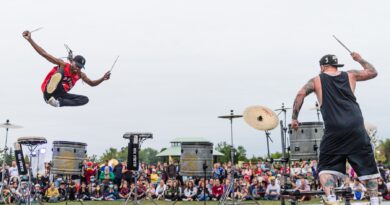Balancing on the Edge’s “Anthropic Traces” defies all description to make its memorable mark

When thinking about Anthropic Traces, the word “ineffable” keeps coming to mind.
Working from the outside in, the work’s title conjures mysterious archeological or detective work. The term “anthropic”, which sounds both familiar and alien, means “caused by humans.” This mind-bending multimedia and multidisciplinary show enacts the traces – rather, the deep scars – left on the planet and its peoples by human existence in the Athropocene era, when human activity has become the dominant influence on the climate and environment.
To tie it together, this large-scale show (10 performers and 8 musicians) prioritizes the themes of the ongoing water crisis, the human impact on the environment and Indigenous identity over a single throughline, specific characters, or even a specific genre.
This is not circus in the traditional sense. It’s not theatre in any obvious way. Nor is it dance. Anthropic Traces boldly re-mixes all of these disciplines with unsettling contemporary and experimental live music, comedia dell’arte, and circus performances. In doing so, the show sidesteps description of what it is, instead inviting us to consider how it feels.
The show is preceded by a brief, earnest personal reflection on the climate crisis by a local climate change battler. Sobering but unsensational, and balanced rather than histrionic, it locates the show at the nexus of the individual and the existential. The show itself is presented in two acts. Each begins with “Threads That Bind”, three scenes that weave together stories that the show’s creators gathered about travel that impacted the trajectory of peoples’ lives. Here, the show reimagines clowns through the use of bank heist-evoking masks (designed by Melody Anderson) to represent multigenerational travelers. These evocative and witty scenes grab the attention with choreographed movement and physical comedy.

The first “Threads that Bond” scene depicts a bustling airport where chance encounters collide with planned excursions. Some passengers are relocating. Some are rushed. Some are departing., while others are arriving. Still others are detained: shifted without explanation from purposeful travellers to distressed observers. Next is a genre-defying performance by Amy Hull on the aerial drum that is punctuated with a pointed monologue about intersectional Indigenous identity. A duet performance closes the first act. Manipulating giant blocks, contortionist Samantha Halas and juggler Louis Wei-Chun Barbier build, tear down, rebuild and seek variously to navigate a wall between them, This eloquent sequence conveys emotional depth and nuance without the utterance of a single word.
And all the while, a large digital clock ticks loudly, marking the passing minutes in increasingly incoherent fashion. The time is very much out of joint.
The second act opens with masked actors who, in a thematic complement to the airport scene, are train travelers to the seaside. Unlike the bustle of the airport scene, this non-commutative journey introduces several themes: the cycle of life, death, and renewal; water as a source of life and pleasure; unequal access to water, and the effects of pollution on it.
This act uses breathtaking and sophisticated projections to realize the train trip, and includes impressive performances that leverage bungee cords, hair suspension and silk dancing – here provocatively substituted with plastic sheeting. Subsequent projections help to realize the swimming of Lara Ebata and Samantha Halas, who dance the front crawl. Nicole Malbeuf’s work in the Hair Hang, Lara Ebata’s Rope and Harness, and Natasha Danchenko’ Aerial Plastic are simply mesmerizing. Plastic is visually prominent, aurally discordant and appropriately jarring. Malbeuf’s suffocating plastic costume undulates as she moves. Plastic bottles attached to its base – which cannot be detached – visually underscore some of the most pernicious and thoughtless anthropic traces our species continues to leave behind us.

Anthropic Traces is presented by Balancing on The Edge in association with Thin Edge New Music Collective and A Girl in the Sky; co-directed by Rebecca Leonard and Sonia Norris, with Musical Direction by Ilana Waniuk and Cheryl Duvall. The 80-minute show is visually and sonically arresting, thoroughly thought-provoking and memorable.
We humans continue to leave indelible marks on our world – marks which will impact our fellow travellers and our planet well beyond our lifetimes. Audiences of Anthropic Traces are in for a provocative and breathtaking journey that invites reflection, inspires urgency and hope – and is liable to spark a return visit.
Reserve tickets to Anthropic Traces on crowstheatre.ca.
© Arpita Ghosal, SesayArts Magazine 2022
About The Author
Arpita Ghosal
Arpita Ghosal is a Toronto-based arts writer. She founded Sesaya in 2004 and SesayArts Magazine in 2012.
Visit About Us > Meet the Team to read Arpita’s full bio …




